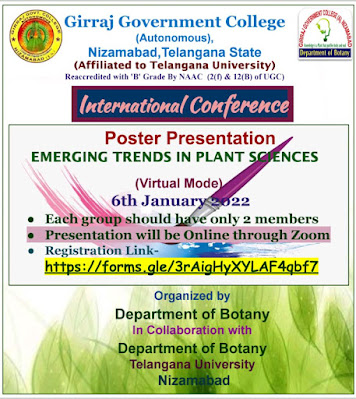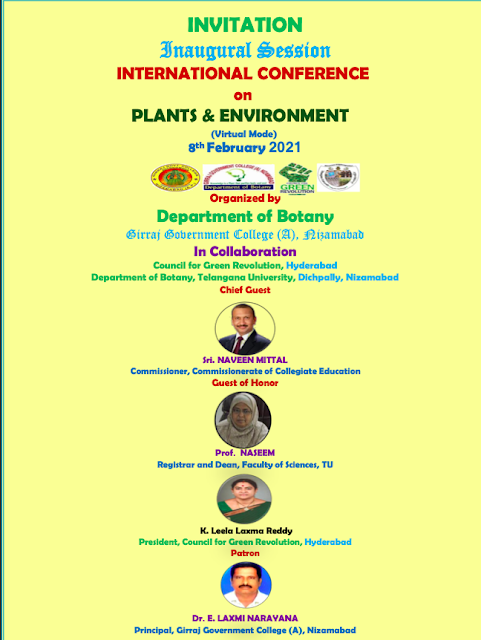Botany First Year, I -Semester Syllabus
GIRRAJ GOVERNMENT COLLEGE (A),NIZAMABAD
B.Sc., BOTANY
First
Year, I -Semester
Paper-I;
Microbial Diversity and Lower Plants
DSC - 1A (4 hrs. /week)
Credits- 4
Theory Syllabus (60 hours)
UNIT – I (15
hours)
1.
Bacteria: Structure, nutrition,
reproduction and economic importance. Brief account of Archaebacteria,
Actinomycetes and Mycoplasma with reference to little leaf of Brinjal and
Papaya leaf curl
2.
Viruses: Structure, replication and
transmission; plant diseases caused by viruses and their control with reference
to Tobacco Mosaic and Rice Tungro.
3.
An outline of plant diseases of
important crop plants caused by bacteria and their control with reference to
Angular leaf spot of cotton and Bacterial blight of Rice.
UNIT-II (15
hours)
1.
General characters, structure,
reproduction and classification of algae (Fritsch)
2.
Cyanobacteria: General characters, cell
structure their significance as biofertilizers with special reference to
Oscillatoria, Nostoc and Anabaena.
3.
Structure and reproduction of the
following: Chlorophyceae- Volvox, Oedogonium and Chara. Phaeophyceae-
Ectocarpus Rhodophyceae- Polysiphonia.
UNIT-III (15
hours )
1.
General characters and classification of
fungi (Ainsworth).
2.
Structure and reproduction of the
following: (a) Mastigimycotina- Albugo (b) Zygomycotina- Mucor (c)
Ascomycotina- Saccharomyces and Penicillium. (d) Basidiomycotina- Puccinia (e)
Deuteromycotina- Cercospora.
3.
Economic importance of lichens
UNIT-IV
(15 hours )
1.
Bryophytes: Structure, reproduction,
life cycle and systematic position of Marchantia, Anthoceros and Polytrichum,
Evolution of Sporophyte in Bryophytes.
2.
Pteridophytes: Structure, reproduction,
life cycle and systematic position of Rhynia, Lycopodium, Equisetum and
Marsilea.
3.
Stelar evolution, heterospory and seed
habit in Pteridophytes.
References:
1. Alexopolous,
J. and W. M. Charles. 1988. Introduction to Mycology. Wiley Eastern, New Delhi.
2. Mckane, L. and K. Judy. 1996. Microbiology –
Essentials and Applications. McGraw Hill, New York.
3. Pandey,
B. P. 2001. College Botany, Vol. I: Algae, Fungi, Lichens, Bacteria, Viruses,
Plant Pathology, Industrial Microbiology and Bryophyta. S. Chand & Company
Ltd, New Delhi.
4. Pandey,
B. P. 2007. Botany for Degree Students: Diversity of Microbes, Cryptogams, Cell
Biology and Genetics. S. Chand & Company Ltd, New Delhi.
5. Sambamurthy,
A. V. S. S. 2006. A Textbook of Plant Pathology. I. K. International Pvt. Ltd.,
New Delhi.
6. Sambamurthy,
A. V. S. S. 2006. A Textbook of Algae. I. K. International Pvt. Ltd., New
Delhi.
7. Sharma,
O. P. 1992. Textbook of Thallophyta. McGraw Hill Publishing Co., New Delhi.
8. Thakur,
A. K. and S. K. Bassi. 2008. A Textbook of Botany: Diversity of Microbes and
Cryptogams. S. Chand & Company Ltd, New Delhi.
9. Vashishta,
B. R., A. K. Sinha and V. P. Singh. 2008. Botany for Degree Students: Algae. S.
Chand& Company Ltd, New Delhi.
10. Vashishta,
B. R. 1990. Botany for Degree Students: Fungi, S. Chand & Company Ltd, New
Delhi.
11. Dutta
A.C. 2016. Botany for Degree Students. Oxford University Press.
12. Watson,
E. V. 1974. The structure and life of Bryophytes, B. I. Publications, New
Delhi.
13. Pandey,
B. P. 2006. College Botany, Vol. II: Pteridophyta, Gymnosperms and Paleobotany.
S. Chand & Company Ltd, New Delhi.
14. Vashishta,
P. C., A. K. Sinha and Anil Kumar. 2006. Botany - Pteridophyta (Vascular
Cryptogams). . Chand & Company Ltd, New Delhi.
15. Pandey,
B. P. 2001. College Botany, Vol. I: Algae, Fungi, Lichens, Bacteria, Viruses,
Plant Pathology, Industrial Microbiology and Bryophyta. S. Chand & Company
Ltd, New Delhi.
16. Pandey,
B. P. 2007. Botany for Degree Students: Diversity of Microbes, Cryptogams, Cell
Biology and Genetics. S. Chand & Company Ltd, New Delhi.
17. Thakur,
A. K. and S. K. Bassi. 2008. A Textbook of Botany: Diversity of Microbes and
Cryptogams. S. Chand & Company Ltd, New Delhi.
18. Vashishta,
B. R., A. K. Sinha and Adarsha Kumar. 2008. Botany for Degree Students:
Bryophyta. S. Chand & Company Ltd, New Delhi
GIRRAJ GOVERNMENT COLLEGE (A), NIZAMABAD
B.Sc., BOTANY
First
Year Semester - I
Paper-I;
Microbial Diversity and Lower Plants
Practical
Syllabus
(45 hours)
1. Study
of viruses and bacteria using electron micrographs (photographs).
2. Gram
staining of Bacteria.
3. Study
of symptoms of plant diseases caused by viruses, bacteria, Mycoplasma and
fungi: Viruses: Tobacco mosaic Bacteria: Angular leaf spot of cotton and Rice
tungro. Mycoplasma: Little leaf of Brinjal and Leaf curl of Papaya Fungi: White
rust on Crucifers, Rust on wheat & Tikka disease of Groundnut.
4. Vegetative
and reproductive structures of the following taxa:
Algae: Oscillatoria, Nostoc, Volvox,
Oedogonium,Chara, Ectocarpus and Polysiphonia.
Fungi: Albugo, Mucor,Saccharomyces,
Penicillium, Puccinia and Cercospora
5. Section
cutting of diseased material infected by Fungi and identification of pathogens
as per theory syllabus.
White rust of Crucifers,
Rust on wheat & Tikka disease of
Groundnut.
6. Lichens:
Different types of thalli and their external morphology
7. Examination
of important microbial, fungal and algal products: Biofertilizers, protein
capsules, antibiotics, mushrooms, Agar-agar etc.
8. Field
visits to places of algal / microbial / fungal interest (e.g. Mushroom
cultivation, water bodies).
9. Study
of Morphology (vegetative and reproductive structures) and anatomy of the
following Bryophytes: Marchantia, Anthoceros and Polytrichum.
10. Study
of Morphology (vegetative and reproductive structures) and anatomy of the
following Pteridophytes: Lycopodium, Equisetum and Marsilea.
11. Study
of Anatomical features of Lycopodium stem, Equisetum stem and Marsilea petiole
& rhizome by preparing double stained permanent mounts.
GIRRAJ
GOVERNMENT COLLEGE (A), NIZAMABAD
B.Sc., BOTANY
First
Year, I -Semester
Paper-I;
Microbial Diversity and Lower Plants
Practical Model Paper
Time : 3
hrs
Max. Marks: 50
I.
Identify the given components
‘A’&‘B’ in the algal mixture. 2 X 5 = 10M
(Describe with neat labeled
diagrams & give reasons for the classification.
II.
Classify the given bacterial
culture ‘C’ using Gram – staining technique. 4M
III.
Take a transverse section of given
diseased material ‘D’. 6M
Identify & describe the symptoms
caused by the pathogen.
IV.
Take a transverse section of given
material ‘É’ and prepare a temporary slide. 9M
Identify
and describe it with a labeled diagram
V.
Identify the given specimens ‘F’,
‘G’ & ‘H’ by giving reasons. 3 X 2 = 6M
(Fungal-1, Bacteria-1 &
Viral-1)
VI.
Comment on the given slides ‘I’
& ‘J’ 2 X 2 = 4M
(Algae-1, Fungi-1)
VII.
Identify the given specimen ‘K’
& slides ‘L’, ‘M’ 3 X 2 =
6M
(Bryophytes &
Pteridophytes )
VIII.
Record 5M
GIRRAJ
GOVERNMENT COLLEGE (A), NIZAMABAD
B.Sc., BOTANY
First
Year, I -Semester
Paper-I;
Microbial Diversity and Lower Plants
Practical Question Bank
Time: 3
hrs
Max. Marks: 50
I.
Identify
the given components ‘A’&‘B’ in the algal mixture. 2 X 5 = 10M
(Describe with neat labeled diagrams & give reasons for the
classifications.)
(Slide Preparation – 1; Classification – ½ ; Diagram – ½ ; Description –
2)
1.
Oscillatoria,
2.
Nostoc,
3.
Volvox
4.
Oedogonium
5.
Chara
6.
Ectocarpus
7.
Polysiphonia
II.
Classify the given bacterial culture ‘D’
using Gram – staining technique. 4M
(Procedure
– 1, Identification – 1, Diagram – 1)
8. Gram
Positive Bacteria
9. Gram
Negative Bacteria
III.
Prepare
Transverse Section of the diseased material as a temporary mount ‘E’. Identify
the pathogen giving reasons and describe with the help of diagrams 6M
(Preparation – 1, Identification – 1,
Diagram – 1, Description – 2 Classification – 1)
10. White
Rust on Crucifers
11. Rust
on Wheat
12. Tikka
Disease of Groundnut
IV.
Prepare
a transverse section of given material ‘É’ and prepare a temporary slide. 9M
Identify and describe it with a labeled
diagram
(Preparation – 1, Identification – 1,
Diagram – 2, Description – 2, Classification - 1)
13. Lycopodium Stem
14. Equisetum Stem
15. Marsilea Petiole/Rhizome
V.
Identify the given specimens ‘F’, ‘G’ & ‘H’ by
giving reasons. 3 X 2 = 6M
(Fungal-1, Bacteria-1
& Viral-1)
16. Tobacco
Mosaic Virus
17. Angular
Leaf Spot of Cotton
18. Papaya
Leaf Curl
19. Rice
Tungro Disease
20. Puccinia
rust on Wheat
21. Puccinia
rust on Barberry
22. Leaf
blight of Rice
23. Citrus
Canker
24. Little
Leaf of Brinjal
25. White
Rust on Crucifers
26. Tikka
Disease of Groundnut
27. Crustose
Lichens
28. Foliose
Lichens
29. Fruticose
Lichens
VI.
Comment on the given slides ‘I’ & ‘J’
2 X 2 = 4M
(Fungi-2)
1. Albugo
conidia-
2. Albugo
Oospore
3. Mucor
Vegetative
4. Saccharomycese
Vegetative/Budding
5. Penicillium
Condia
6. Penicillium
ascocarp
7. Puccinia
Uredial stage
8. Puccinia
telial Stage
9. Puccinia
Pycnidial Stage
10. Puccinia
Aecial Stage
11. Cercospora
Conidia
VII.
Identify
the given specimen ‘K’ & Slide ‘L’
2 X 3 = 6 M
(Bryophytes &
Pteridophytes )
Specimens:
12. Marchantia
thallus with gemma cups
13. Marchantia thallus with antheridiophore
14. Marchantia thallus with archegoniophore
15. Anthoceros thallus
16. Anthoceros with sporophyte
17. Polytrichium with sporophyte
18. Lycopodium with cone
19. Equisetum with cone
20. Marsilea
with sporocarp
Slides:
21. Marchantia
thallus V.S.
22. Marchantia
thallus with gemma cups
23. Marchantia
antheridiophore L.S.
24. Marchantia
archegoniophre L.S.
25. Marchantia
sporophyte V.S.
26. Anthoceros
thallus V.S.
27. Anthoceros
thallus with antheridia
28. Anthoceros
thallus with archegonia
29. Anthoceros
sporophyte L.S.
30. Polytrichum
leaf T.S.
31. Polytrichum
stem T.S.
32. Polytrichum
antheridial branch
33. Polytrichum
archegonial branch
34. Polytrichum
capsule L.S.
35. Rhynia
(Fossil slide)
36. Lycopodium
strobiuls L.S.
37. Equisetum
strobilus L.S.
38. Marsilea
sporocarp V.S.
VIII.
Record
5M



Comments
Post a Comment